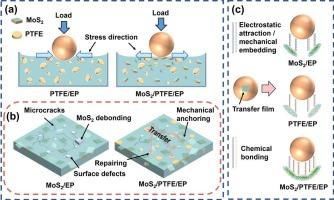Synergistic mechanism of MoS2 and PTFE in reinforcing epoxy-based composite coatings
IF 6.1
2区 材料科学
Q1 MATERIALS SCIENCE, COATINGS & FILMS
引用次数: 0
Abstract
To address the urgent demand for enhanced durability and tribological performance of epoxy (EP) coatings in transmission components such as sliding bearings and gears, this study proposes a novel “soft–hard” synergistic filler strategy by incorporating MoS2 and PTFE into an EP matrix. Although EP possess strong adhesion and chemical resistance, their inherent brittleness and poor wear resistance severely restrict their application under high mechanical loads. While various fillers have been investigated to improve EP's tribological properties, the combination of soft PTFE with hard MoS2 offers a promising yet underexplored approach to simultaneously enhance toughness, reduce friction, and improve wear resistance. In this work, the effects of MoS2 and PTFE on the mechanical and tribological properties of the EP matrix were systematically investigated using scanning electron microscopy, X-ray diffraction, and X-ray photoelectron spectroscopy, and their synergistic mechanism was elucidated. The results indicated that MoS2 effectively enhanced the elastic modulus and hardness of the coating, while PTFE diminished these properties. When co-incorporated, the MoS2/PTFE/EP coating exhibited the lowest coefficient of friction and wear rate, which were significantly reduced by 74.2 % and 97.3 %, respectively, compared to those of the pure EP coating. This remarkable performance enhancement was primarily attributed to the synergistic effects of MoS2 and PTFE in three aspects: complementary mechanical properties, enhanced interfacial stability, and the formation of a robust, continuous composite transfer film. This study provides a key strategy and theoretical foundation for the filler design of high-performance, long-service-life EP-based self-lubricating coatings.

二硫化钼和聚四氟乙烯增强环氧基复合涂料的增效机理
为了满足滑动轴承和齿轮等传动部件对环氧树脂(EP)涂层增强耐用性和摩擦学性能的迫切需求,本研究提出了一种新的“软硬”协同填料策略,将MoS2和PTFE加入EP基体中。虽然EP具有很强的附着力和耐化学性,但其固有的脆性和较差的耐磨性严重限制了其在高机械载荷下的应用。虽然已经研究了各种填料来改善EP的摩擦学性能,但软PTFE与硬MoS2的组合提供了一种有前途但尚未开发的方法,可以同时增强韧性,减少摩擦和提高耐磨性。本文采用扫描电镜、x射线衍射和x射线光电子能谱等方法系统研究了二硫化钼和聚四氟乙烯对EP基体力学和摩擦学性能的影响,并阐明了它们的协同作用机制。结果表明,MoS2有效提高了涂层的弹性模量和硬度,而PTFE则降低了涂层的弹性模量和硬度。与纯EP涂层相比,MoS2/PTFE/EP涂层的摩擦系数和磨损率分别降低了74.2%和97.3%。这种显著的性能增强主要归因于MoS2和PTFE在三个方面的协同作用:互补的力学性能,增强的界面稳定性以及形成坚固的连续复合转移膜。该研究为高性能、长寿命ep基自润滑涂层填料设计提供了关键策略和理论基础。
本文章由计算机程序翻译,如有差异,请以英文原文为准。
求助全文
约1分钟内获得全文
求助全文
来源期刊

Surface & Coatings Technology
工程技术-材料科学:膜
CiteScore
10.00
自引率
11.10%
发文量
921
审稿时长
19 days
期刊介绍:
Surface and Coatings Technology is an international archival journal publishing scientific papers on significant developments in surface and interface engineering to modify and improve the surface properties of materials for protection in demanding contact conditions or aggressive environments, or for enhanced functional performance. Contributions range from original scientific articles concerned with fundamental and applied aspects of research or direct applications of metallic, inorganic, organic and composite coatings, to invited reviews of current technology in specific areas. Papers submitted to this journal are expected to be in line with the following aspects in processes, and properties/performance:
A. Processes: Physical and chemical vapour deposition techniques, thermal and plasma spraying, surface modification by directed energy techniques such as ion, electron and laser beams, thermo-chemical treatment, wet chemical and electrochemical processes such as plating, sol-gel coating, anodization, plasma electrolytic oxidation, etc., but excluding painting.
B. Properties/performance: friction performance, wear resistance (e.g., abrasion, erosion, fretting, etc), corrosion and oxidation resistance, thermal protection, diffusion resistance, hydrophilicity/hydrophobicity, and properties relevant to smart materials behaviour and enhanced multifunctional performance for environmental, energy and medical applications, but excluding device aspects.
 求助内容:
求助内容: 应助结果提醒方式:
应助结果提醒方式:


